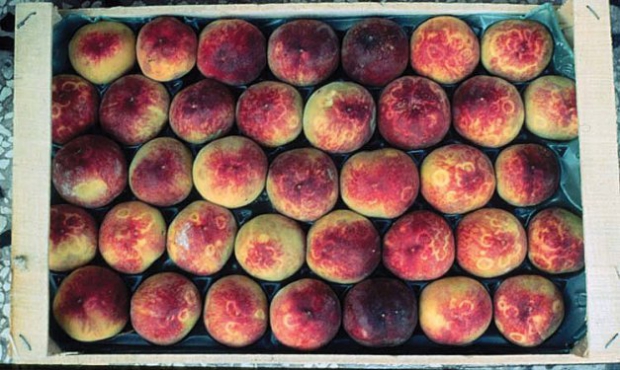
Plum pox-infected trees will ultimately produce low yields of deformed, mottled fruit. The virus is detected through testing, so symptomatic fruit is seldom seen.
In the “usual” journalistic process, reporters find expert sources and ask questions, then ask additional questions as the answers dictate. This process did not work in developing this article.
On both sides of the U.S.-Canadian border, phone calls directed to knowledgeable horticulturists involved in the plum pox programs were shunted to media relations people, who agreed to provide answers to specific questions. Efforts to bypass “the system” resulted in intercepted e-mail messages.
In response to Good Fruit Grower’s questions, the office of media relations for the Canadian Food Inspection Agency (CFIA) sent this by e-mail: “The plum pox virus (PPV) eradication effort has been replaced with a monitoring and management program. The intent of the program is to mitigate the spread of PPV and to provide information to assist in managing the impacts of the virus.
“The Plum Pox Virus Monitoring and Management Program’s (PPMMP) focus is to mitigate the spread of PPV beyond the current plum pox quarantine area in the Niagara area. The CFIA will collect samples around the periphery of the quarantine area to determine if PPV is spreading.
“Since PPV is known to spread via infected material, a Ministerial Order (Plum Pox Virus Infested Order, 2008) is in place to prohibit moving regulated material of PPV-host fruit and ornamental trees outside of the quarantine area. To reduce the rise in PPV incidence, a propagation ban is in place within the quarantine area for PPV-host material. Propagation includes the production of new plants from seed, cuttings, grafting or any other method. The CFIA encourages that Best Management Practices, developed by the Ontario Ministry of Agriculture, Food and Rural Affairs, are adopted to reduce the impact of PPV.”
The response from APHIS, which has relocated its plum pox program headquarters to New York, was this:
“The PPV program is continuing to survey for the presence of PPV in northwestern New York. The last time a positive was found was in 2011. Until a new positive is found, there will be no eradication activity. PPV remains a priority pest for APHIS. Congress provided appropriated funds for PPV in 2012 as it has done for past years.
“New York is the only state with an active eradication program in place. Last positive was identified in 2011 (1 positive tree in Niagara County). Other states continue to survey for PPV.
“The PPV program will continue to follow the current eradication protocol. No change has been instituted. APHIS and CFIA have ongoing bilateral discussions on PPV. U.S. and Canadian scientists participate on each other’s Science Panels and Technical Working Groups.”

Leave A Comment